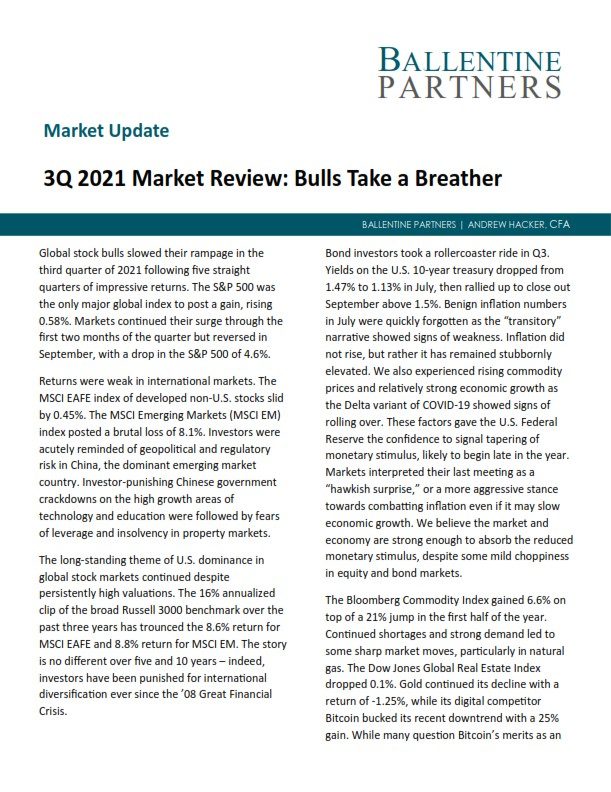Global stock bulls slowed their rampage in the third quarter of 2021 following five straight quarters of impressive returns. The S&P 500 was the only major global index to post a gain, rising 0.58%. Markets continued their surge through the first two months of the quarter but reversed in September, with a drop in the S&P 500 of 4.6%.
Returns were weak in international markets. The MSCI EAFE index of developed non-U.S. stocks slid by 0.45%. The MSCI Emerging Markets (MSCI EM) index posted a brutal loss of 8.1%. Investors were acutely reminded of geopolitical and regulatory risk in China, the dominant emerging market country. Investor-punishing Chinese government crackdowns on the high growth areas of technology and education were followed by fears of leverage and insolvency in property markets.
The long-standing theme of U.S. dominance in global stock markets continued despite persistently high valuations. The 16% annualized clip of the broad Russell 3000 benchmark over the past three years has trounced the 8.6% return for MSCI EAFE and 8.8% return for MSCI EM. The story is no different over five and 10 years – indeed, investors have been punished for international diversification ever since the ’08 Great Financial Crisis.
Bond investors took a rollercoaster ride in Q3. Yields on the U.S. 10-year treasury dropped from 1.47% to 1.13% in July, then rallied up to close out September above 1.5%. Benign inflation numbers in July were quickly forgotten as the “transitory” narrative showed signs of weakness. Inflation did not rise, but rather it has remained stubbornly elevated. We also experienced rising commodity prices and relatively strong economic growth as the Delta variant of COVID-19 showed signs of rolling over. These factors gave the U.S. Federal Reserve the confidence to signal tapering of monetary stimulus, likely to begin late in the year. Markets interpreted their last meeting as a “hawkish surprise,” or a more aggressive stance towards combatting inflation even if it may slow economic growth. We believe the market and economy are strong enough to absorb the reduced monetary stimulus, despite some mild choppiness in equity and bond markets.
The Bloomberg Commodity Index gained 6.6% on top of a 21% jump in the first half of the year. Continued shortages and strong demand led to some sharp market moves, particularly in natural gas. The Dow Jones Global Real Estate Index dropped 0.1%. Gold continued its decline with a return of -1.25%, while its digital competitor Bitcoin bucked its recent downtrend with a 25% gain.2 While many question Bitcoin’s merits as an inflation hedge, it appears to be functioning better in that respect than gold.
Outlook & Strategy
The overall economic environment is that of slowing growth and less accommodative fiscal and monetary policy. There is a lot of uncertainty in the markets around inflation, supply chain issues, and dysfunction in Washington, D.C. We expect most of these concerns to work themselves out over the coming quarters and see a good case to be made for higher equity prices by the end of next year. Relatively high GDP and earnings growth, albeit at lower rates than last year, should be a boon for investors. Strong productivity growth from technological innovation has buoyed corporate profit margins, which should help offset cost pressures from a tight labor market.
An interesting historical comparison to the current environment can be seen in late 2018, when the “sugar high” from the 2017 corporate tax cuts was fading. The U.S. Federal Reserve was raising interest rates aggressively while global growth was facing headwinds from the U.S.-China trade war. Stock markets faced a very difficult fourth quarter. Fed Chairman Jerome Powell’s comment in December 2018 that interest rates were “a long way from neutral” was the straw that broke the market’s back. We do not expect aggressive monetary tightening this time around. The Fed has changed its inflation-targeting process to tolerate above-average inflation following periods when it has been muted. We just experienced a long period of very low inflation, and thus, the Fed is taking a less combative approach to rising prices. Yet, withdrawal of stimulative economic policies often comes with market “tantrums.”
From an economic growth perspective, we are experiencing a positive impulse from economic “reopening” or “return to normal activities.” But on the other side of the coin is a tight job market, less fiscal spending, and (slowly) tightening financial conditions. Last week Goldman Sachs reduced their forecast for third-quarter U.S. GDP growth from 5.5% to 4.5%.3 A little over a month ago, they were predicting 8.5% growth. We expect a steady decline in growth towards the long-term U.S. trend growth rate of about 2%.
The direction of inflation will be crucial for markets. Offsetting the potential for sustained higher inflation are the significant efficiency gains from large U.S. corporations over the last two years and relatively high personal income from a strong job market.
Interest rates rose in Q3 but remain undeniably low relative to 5.9% consensus estimates for the annualized change in the Consumer Price Index.4 Investors remain willing to pay up for bonds for several reasons. Inflation data does reflect declining price gains on a quarter-over-quarter basis. The Fed’s willingness to fight inflation via reduced bond purchases followed by rate hikes gives investors comfort that prices are under control. Finally, the long-term deflationary forces of demographics and technology, which sent rates lower for the past several decades, remain strong. Investors must always remember that technology is a powerful deflationary force.
We view the stock market pullback of recent months as more of a “consolidation” than a correction. Investors remain worried about inflation but have also keyed in on solvency concerns in Chinese property markets and tightness in energy markets in Europe. Markets often find a way to climb such “walls of worry” as the strong underlying fundamentals of the U.S. consumer and economy shine through. We view moderate corrections in stock markets as healthy given strong recent performance and continue to view stocks, real assets, and private investments as the best opportunities for long-term compounding and protection from inflation.
1 Tradingview
2 Tradingview
3 Goldman Sachs Global Investment Research
4 FactSet
About Andrew Hacker, CFA
Andrew is a Senior Research Analyst at the firm and is responsible for research coverage of global equity markets. He is responsible for portfolio construction & manager selection for publicly traded equities. His research also contributes to our overall market outlook.
This report is the confidential work product of Ballentine Partners. Unauthorized distribution of this material is strictly prohibited. The information in this report is deemed to be reliable. Some of the conclusions in this report are intended to be generalizations. The specific circumstances of an individual’s situation may require advice that is different from that reflected in this report. Furthermore, the advice reflected in this report is based on our opinion, and our opinion may change as new information becomes available. Nothing in this presentation should be construed as an offer to sell or a solicitation of an offer to buy any securities. You should read the prospectus or offering memo before making any investment. You are solely responsible for any decision to invest in a private offering. The investment recommendations contained in this document may not prove to be profitable, and the actual performance of any investment may not be as favorable as the expectations that are expressed in this document. There is no guarantee that the past performance of any investment will continue in the future.




